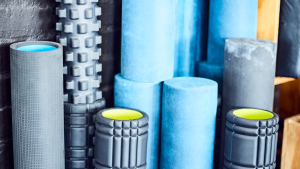No products in the cart.
When and How to Use A Foam Roller
- Posted on

Foam rollers are everywhere! You see them on Amazon, in sporting goods stores, and even your local Target and Walmart carry them. They come in all sizes, textures, and densities, but you will seldom find any instruction with them but the images on them always have a smiling person using them (the image for our blog was the first one to come up! LOL). It seems like a bit of false advertising since I couldn’t tell you the last time I was using a foam roller and smiling! All joking aside, these devices are absolute life savers, but we want to help you decide when and how to use yours based on the texture and density of your foam roller. We find the best way to define the time of application into density and texture.
 Texture: Foam rollers have a wide range of textures. For simplicity’s sake, we will break these down into three classifications: smooth, bumpy, and rough.
Texture: Foam rollers have a wide range of textures. For simplicity’s sake, we will break these down into three classifications: smooth, bumpy, and rough. Density: For simplicity, we will define foam rollers as firm or soft. Firm foam rollers could be made of dense foam or plastic and have little to no give if you press them with a finger. Soft rollers are wrapped in foam, and you can easily push into them with a finger.
Using these definitions, we have to consider timing and purpose. For example, the goal of foam rolling can change depending on when you are rolling.
Recovery: Sometimes, foam rolling aims to create an experience more like a post-workout or post-race massage where you want to aid in the recovery process and reduce soreness. In this instance, a smooth roller that is less dense will best suit your goals. In addition, as you are already dealing with irritated and potentially sore tissue, you do not want to add any additional tissue but aid in blood flow and the movement of extracellular fluid.
Maintenance: We would view maintenance as our attempt to improve our overall physical status, whether the goal is improving flexibility, range of motion, or simply working out “knots.” In this instance, we often recommend a more textured foam roller. These can be very aggressive like a RumbleRoller or slightly less textured like the Trigger Point Grid Foam Roller.
When looking at density, you will want to factor in your personal preferences and the pain threshold. It may be better to take the concept of “less is more,” where if you purchase a less dense roller, you will be able to use it in more circumstances.
There may be no perfect foam roller for you, and you may find several foam rollers necessary. But, if the budget doesn’t allow, it may be best for you to choose the roller you can use in most circumstances, which I believe is a smooth medium density roller.
